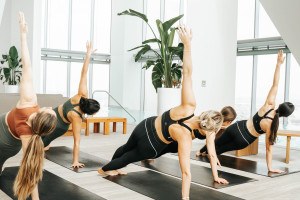Broad Street Run Training: Why You Shouldn’t Skip Your Cross-Training Days
“Wait, you’re telling me I have to do more than just run?”
Yes, that’s exactly what I’m saying. If you want to be the best runner you can be at this year’s Broad Street Run, you need to add activities other than running to your training. You need to cross-train.
At its most basic level, cross-training is engaging in two or more sports or activities in order to improve fitness and performance, especially in a main sport, which in our case is running.
As with any exercise, cross-training must have a purpose, a specific reason you’re doing it. Similar to running, haphazardly incorporating cross-training into your training plan is not the most effective use of your time. You should ask yourself: “Why am I adding cross training to my training in the first place? What’s my goal?”
To help answer those questions, let’s break cross-training activities into categories and discuss the purpose of each. Then I’ll explain how to incorporate each cross-training activity into your Broad Street Run training plan.
Types of Cross-Training Activities
Cardiovascular Exercises
What: This is what most people think of when they think cross-training: elliptical, biking, swimming, rowing, etc.
Why: Maintain or improve cardiovascular fitness without the impact or stress caused by running while improving muscular strength.
How: Should be treated similarly to running and can be used during periods when running isn’t an option, such as during an injury, or on a recovery day.
Strength
What: This includes weight-training and bodyweight exercises. Examples of strength-training routines can be found here.
Why: The primary purpose is to strengthen running and non-running muscles, produce more power with each foot-strike, resist muscle fatigue and reduce the chance of running-related injuries.
How: Introduce early in training cycle and continue through a taper leading up to goal race. Ideally, this should be done twice a week on the day of a hard workout or long run, following the workout. Note: Form is absolutely essential when doing strength exercises. Bad form will cause injury.
Flexibility
What: Stretching, foam rolling or yoga.
Why: To relieve muscle tightness and soreness. This is particularly important for older runners. As we age our hips can lose range of motion and extension. Some believe that greater hip extension at push off is directly correlated with a more efficient powerful stride.
How: Stretching and foam rolling can be performed at any time and multiple times a day. Experts recommend dynamic stretching prior to running and static or dynamic stretching after. Here’s a great foam rolling routine to try.
Drills
What: Dynamic exercises that include skips, bounds, marches, etc. Examples of running drills can be found here.
Why: Perfecting running form and to become a more efficient runner.
How: Perform two to three days per week either prior to a run or after run. Note: Form is absolutely essential when doing drills. Bad form will be counterproductive.
How Often Should I Cross-Train?
There’s no hard-and-fast rule for how often to cross-train. In general, it depends on runner, their ability level and the amount of time they’re able to commit to training. Beginners should probably only concentrate on cardio and flexibility. Intermediates can do cardio, flexibility and strength. And advanced runners should do flexibility, strength and drills.
The only hardened rule when it comes to cross-training is that if cross-training affects your running, you need to cut back on it. Cross-training can help take your running to the next level or keep you fit during time away from running. However, the best way to get better at running is to run. If you’re finding it difficult to balance both cross-training and running, you should re-evaluate your cross-training activities schedule.
……………
Cory Smith, a Philadelphia based running coach, shares his expert advice as an American Cancer Society DetermiNation running coach; founder of Run Your Personal Best, a private running-coaching business; and head cross country coach at Penn State Brandywine. He is a level two USA Track and Field-certified coach and a 4:03 miler. As a student athlete at Villanova, Cory was an NCAA Division One Regional and National Championship qualifier. Contact Cory at cory@runyourpersonalbest.com. Read all of Cory’s posts for Be Well Philly here.
Like what you’re reading? Stay in touch with Be Well Philly — here’s how:
- Like Be Well Philly on Facebook
- Follow Be Well Philly on Twitter
- Follow Be Well Philly on Pinterest
- Get the Be Well Philly Newsletter



